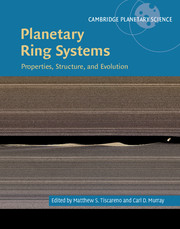Book contents
- Frontmatter
- Contents
- List of Contributors
- Acknowledgements
- I Introductory Material
- II Ring Systems by Location
- III Ring Systems by Type and Topic
- IV Concluding Material
- 19 Future Missions to Planetary Rings
- 20 Planetary Rings and Other Astrophysical Disks
- 21 The Future of Planetary Rings Studies
- Index
- Plate section
- References
20 - Planetary Rings and Other Astrophysical Disks
from IV - Concluding Material
Published online by Cambridge University Press: 26 February 2018
- Frontmatter
- Contents
- List of Contributors
- Acknowledgements
- I Introductory Material
- II Ring Systems by Location
- III Ring Systems by Type and Topic
- IV Concluding Material
- 19 Future Missions to Planetary Rings
- 20 Planetary Rings and Other Astrophysical Disks
- 21 The Future of Planetary Rings Studies
- Index
- Plate section
- References
Summary
This chapter explores the physics shared by planetary rings and the various disks that populate the Universe. It begins with an observational overview, ranging from protoplanetary disks to spiral galaxies, and then compares and contrasts these astrophysical disks with the rings of the solar system. Emphasis is placed on fundamental physics and dynamics, and how research into the two classes of object connects. Topics covered include disk formation, accretion, collisional processes, waves, instabilities, and satellite–disk interactions.
INTRODUCTION
Disks are ubiquitous in astrophysics and participate in some of its most important processes. Most, but not all, feed a central mass: by facilitating the transfer of angular momentum, they permit the accretion of material that would otherwise remain in orbit (Lynden-Bell and Pringle, 1974). As a consequence, disks are essential to star, planet, and satellite formation (McKee and Ostriker, 2007; Williams and Cieza, 2011; Papaloizou and Terquem, 2006; Peale, 1999). They also regulate the growth of supermassive black holes and thus indirectly influence galactic structure and the intracluster medium (Volonteri, 2010; Fabian, 2012). Although astrophysical disks can vary by ten orders of magnitude in size and differ hugely in composition, all share the same basic dynamics and many physical phenomena. This review explores these areas of overlap.
The prevalence of flattened astrophysical systems is a result of dissipation and rotation (Goldreich and Tremaine, 1982). A cloud of gas or debris in orbit around a central mass conserves its total angular momentum but not its energy, as there are numerous processes that may cool the cloud (inelastic physical collisions, Bremsstrahlung, molecular line emission, etc.). As a result, particles’ random velocities are steadily depleted – where “random velocity” is understood to be the component surplus to the circular orbit fixed by the angular momentum. The system contracts into a flat circular disk, the lowest energy state accessible. The contraction ends, and an equilibrium balance is achieved, once the cooling is met by heating (supplied by external irradiation or an internal viscous stress).
Let us define a cylindrical coordinate system with its origin at the central mass and the vertical pointing in the direction of the total angular momentum vector. We describe systems as cold when the pressure gradient is weak and the final equilibrium very thin: radially the dominant force balance is between the centrifugal force and gravity, while vertically it is between pressure and gravity.
- Type
- Chapter
- Information
- Planetary Ring SystemsProperties, Structure, and Evolution, pp. 549 - 576Publisher: Cambridge University PressPrint publication year: 2018
References
- 3
- Cited by

